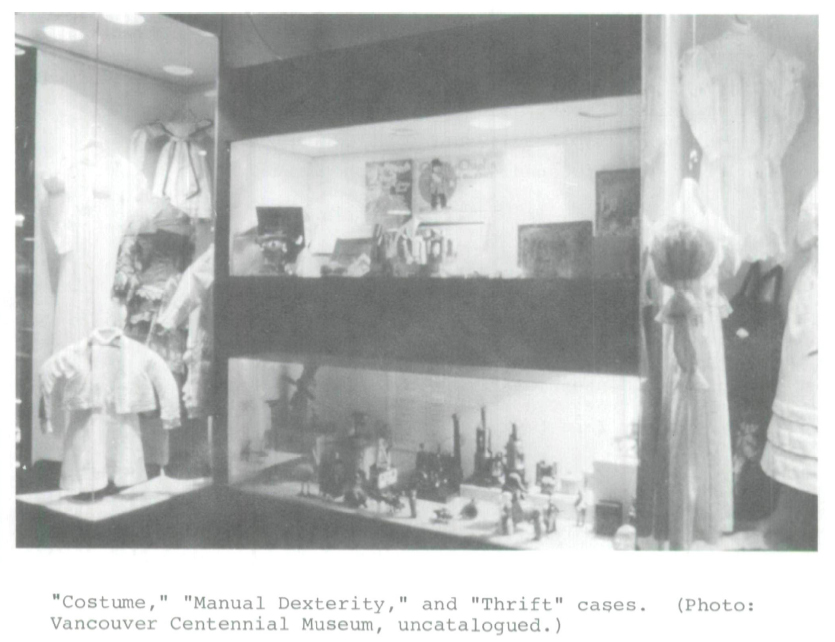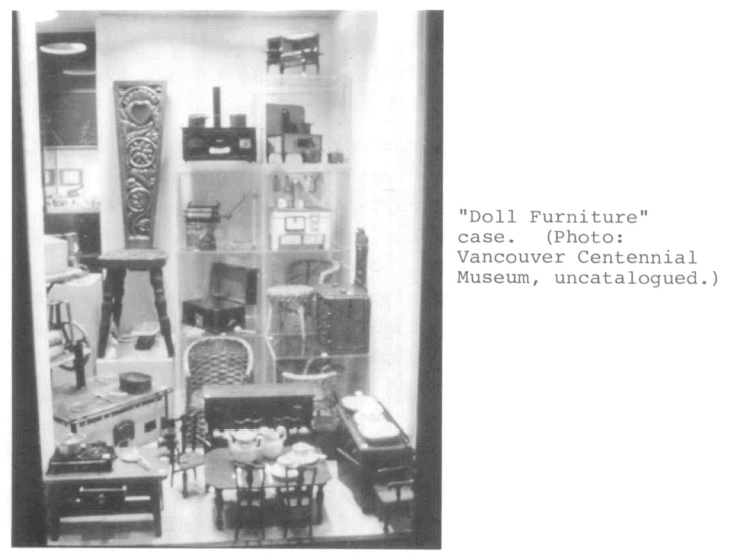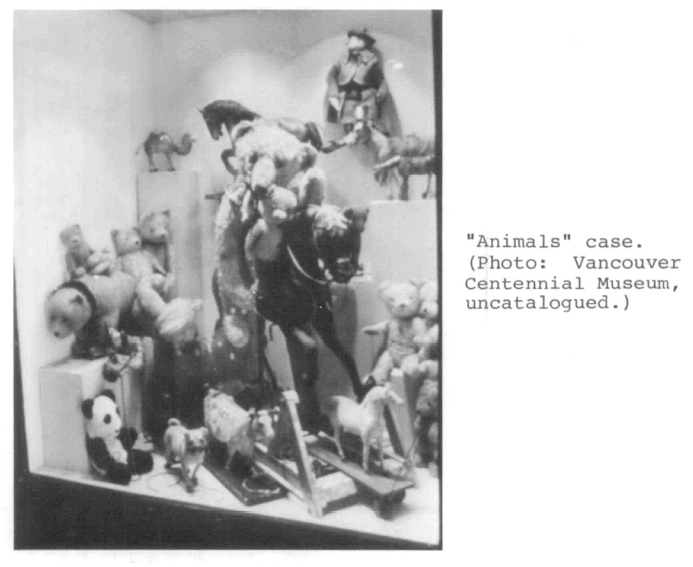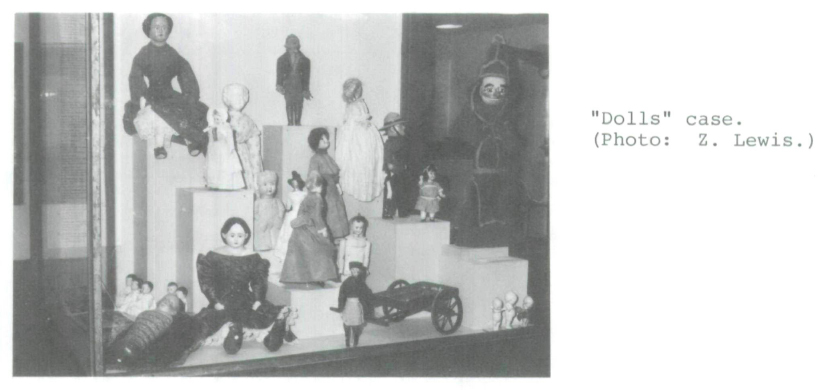Reviews / Comptes rendus
Vancouver Centennial Museum, "The World of Children: Toys and Memories of Childhood".
1 "The World of Children: Toys and Memories of Childhood" opened at the Vancouver Centennial Museum on 26 May 1978 in order to coincide with the International Children's Festival held in adjacent Vanier Park. Originally scheduled to last for two months, repeated requests from the public extended the exhibit to a year. It was designed to be a random reflection on what it was like to be a child with no attempt made to narrow the focus. A more specific approach would have required access to a collection more comprehensive than the Centennial Museum possessed. Instead, a thematic approach was selected covering the major facets of a child's world. Important gaps were filled by making some excellent institutional and private loans. Because of the Festival, it was also decided to include ethnological material from around the world.
2 Captions were provided and some of the cases contained appropriate poems but there was no storyline. This omission did not adversely affect the exhibit since studies seem to indicate that the majority of museum visitors prefer looking to reading. I repeatedly asked myself if copy would have enhanced the exhibit and concluded that because of its general nature it was unlikely than an informative text could have been written. The theme of each case was clear. A text is often necessary to interpret the artifacts, but sometimes they can be left to speak for themselves.
 Display large image of Figure 1
Display large image of Figure 13 The strength of the exhibit lay in its artifacts. The staff successfully resisted the temptation to use only "artsy" items at the expense of representative ones. While there were some rare and striking pieces they were balanced by others that were mundane and plain. Objects from all social classes were used, providing some interesting comparisons and contrasts. It was not until I reflected upon the show that I wondered why some of the museum's larger artifacts, such as a wagon or sleigh, were not used. And yet, the exhibit captured my attention so that I left feeling that I had been in a child's world.
4 The inclusion of ethnological material was frustrating. The objects were fascinating, but once they aroused my interest I became disappointed when there was not more to view. Additional artifacts would have enhanced the educational aspect of the exhibit by helping one to make some tentative conclusions regarding the universal nature of children. Instead, I was left with several unanswered questions: did the museum display all its ethnological material? how representative were the artifacts? how complete were the objects from a particular culture? By including this material the viewer was invited to make comparisons with the Canadian child, but was not provided with enough information to do so properly. The one exception was the Northwest Coast Indian section, which, as far as this non-specialist could determine, was representative and complete.
5 There is an important lesson to be learned here for all museologists. It appears that someone "suggested" that ethno-logical material be included in the exhibit. Curators often assume that they are free to choose the nature and content of the exhibit. In reality, politicians, directors, administrators, and the public often force the exhibit upon the curator. In addition, display or conservation considerations often cause the exclusion or inclusion of certain material since a desired artifact may be too fragile to display or may be the wrong size. At times it may even seem that the curator, who is ultimately responsible for the exhibit, has the least to say about it. It is at this point that the curator's attitude becomes of crucial importance; an inferior exhibit can be excused on the grounds that "it wasn't my idea" or one can demonstrate that quality can be achieved under difficult circumstances.
6 This was the dilemma facing the Centennial Museum's curator. Ethnological material had to be included. Normally one borrows or purchases needed artifacts, but objects of this nature are very rare and difficult to obtain. It was decided, therefore, to provide the viewer with a glimpse since the entire picture could not be shown. This was a valid decision, but a storyline or bibliography would have been helpful since the majority of museum visitors are not familiar with foreign cultures.
7 The major weakness of the exhibit was in its display techniques. In all fairness it must be remembered that the budget was only $1,500 and that there was a reluctance to go "all out" on an exhibit that was only going to last for two months. Consequently, the gallery was left painted black, and the false tin roof and trees, survivors of a 1968 exhibit, were retained. Some of this starkness was relieved by suspending rented merry-go-round horses from the ceiling — an effect which I missed because the horses had been removed prior to my visit. There were twenty-eight cases ranging in size from four to forty-eight feet square; many were five and six feet high. They had been designed for ceramics, rugs, costumes, furniture, and general household items, and were not ideal for most of the children's artifacts. Compounding these difficulties was the fact that the cases could not be arranged in the desired order. All this sounds very familiar; display cases that are never quite right for the artifacts and inadequate budgets are endemic to museologists. Despite their banality, these problems must be tackled if one is to avoid surrendering every time such obstacles are encountered. I ignored the black walls, tin roof, and trees since I was more interested in the contents of the cases than their surroundings.
8 An artifact has to be particularly spectacular in order to overcome being poorly displayed. What confused me was that some cases appeared to be crammed while others were partly empty. For example, one case had so many Teddy bears that some of them were obscured; conversely, a larger case contained a pram with a doll in it and a few other items insufficient to fill it. I have no expertise in display, but the obvious solution of adding or subtracting items comes to mind. There are obvious difficulties in displaying a six-inch object in a case five feet high, but unless a solution is found one is left with too much dead space. This situation occurred with the display of cars and trucks; placed in too large a case they were only a few inches above floor level — an ideal placement for young children but one which left four feet of disturbingly vacant space. This emptiness was magnified since the walls were devoid of support material such as photographs or posters. In addition, the cars were unimaginatively arranged to remind one of a used car lot.
9 Assuming that it is impossible to avoid displaying small artifacts in a large case, there are still viable alternatives. Blocks can be used, for example, to create several visual planes. This was effectively done with the doll collection; blocks not only covered a bare wall and provided several viewing levels, but also isolated each doll, enabling the viewer to appreciate its uniqueness. I found this inconsistency perplexing. Why were some display problems inexpensively but adequately solved while others were allowed to triumph? One must constantly seek solutions to seemingly insurmountable problems if each exhibit is to be as effective as possible and if fellow museologists are to be provided with fresh answers to old problems.
10 The Centennial Museum's display difficulties illustrate the central weakness of many exhibits: lack of planning. Three hundred and eighty-seven artifacts were displayed in seventy-two hundred square feet of gallery. Why was such a large exhibit scheduled to last for only two months? Such a short display time would almost force the staff to adopt an attitude of "why bother?". Those who apply pressure for more frequent temporary displays must be resisted diplomatically and educated to the fact that quality cannot be achieved if the staff is constantly taking down or setting up exhibits. I would suggest that a major exhibit be on display for a minimum of six months and preferably twelve.
11 Considering all the factors, one can empathize with the museum's display problems, but not with the failure to practice better conservation. Although I am not a conservator, I did notice that adult-size hangers were extensively used to support children's costumes. The hangers were made of extra thick wood and gave sufficient support along the top of the shoulders, but because they were too large their ends pushed out the sides of the shoulders. Either the hangers could have been adapted to the size of the costume, or supports should have been made so as not to strain the garment's seams and fabric. Proper conservation practices should have been followed even if the exhibit was scheduled to last only two months.
12 Despite its shortcomings, the "World of Children" was a success. It was very popular with the public which is the ultimate test for all exhibits. Even after my attempts to expose its weak points I must admit that I found it both informative and enjoyable. It did succeed in its intention; "memories of childhood" were evoked as I was led on a nostalgic trip into everyone's past.
 Display large image of Figure 4
Display large image of Figure 4Ivan W. Sayers: Considerations on "The World of Children."
13 In December 1977 the Vancouver Centennial Museum was invited to participate in the programme of the International Children's Festival planned for May 1978. The museum decided to present a two-part exhibition dealing with various aspects of the world of children. The larger section of the exhibit was to use historical material from Canada and its parent western European cultures; the smaller section was to contain ethnological material from around the world.
14 Drawing entirely from the museum's own collection the Ethnology Department was able to present an assortment of artifacts that represented each of the major cultural groups within the metropolitan Vancouver community. We hoped that neither local nor foreign visitors would see the display without finding at least one object with which they could identify.
15 Although the museum does possess many excellent toys and other souvenirs, the History Department's collection was not as comprehensive as that of the Ethnology Department. It was therefore necessary to borrow artifacts from individuals and organizations outside the institution. These lenders provided us with rare and valuable items which normally never leave private hands.
16 The ethnology cases were categorized by geographical area, the history cases by object or function: dolls, vehicles, collections, games, furniture, miniature figures, confections, animals, books, schooling, infancy, costume, thrift, manual dexterity, mechanical aptitude, "home-mades," theatre, and Shirley Temple and Walt Disney. We included everything from an invaluable seventeenth-century Italian figure of the infant Jesus to a valueless but very familiar pair of conkers.
17 Designing the exhibition was definitely a challenge. The gallery is a dark, forbidding room with a large suspended ceiling of corrugated tin, left over from an exhibition of farm machinery. To detract from the sombre dark brown walls all the cases were painted bright yellow, orange, or green. The corrugated roof, left as it was, became a platform supporting twenty-two prancing horses from a 1902 merry-go-round. These horses were lit by a turning mirror ball and spotlights; calliope music played in the background. The horses were a costly rental and had to be returned after five months.
18 Each case was filled to capacity with artifacts. We hoped that the large number of objects would impress the eye, develop the circus atmosphere of the horses and music, and encourage the visitor to return. Many people did come back not once but five or six times.
19 Copy was restricted to a brief identification of each object, its material, its origin, and its ownership. A text was omitted as being unnecessary and frustratingly incomprehensible to the many foreign adults and children expected to be in attendance at the Festival. Strict visual communication had to be chosen over literary communication.
20 The enthusiasm of the remarks in our four books for visitors' comments proved the appeal of the exhibition and even now, when the gallery has been cleared of the "World of Children" for several months, there are daily inquiries about this display.
21 The ethnological material was included as a random complement to the major section of the display, not as its equal or competitor. The inclusion of a large number of Northwest Coast material was an obvious choice since it represented our own native people and since we possess a fine collection from which to draw. It should be noted that this particular case also included Plains and Eastern Woodlands material, this fact being noted on the labels.
22 Since the exhibition was designed with a very young audience in mind the cases were kept at a low height whenever possible. Steps were constructed in front of the taller cases to permit even our youngest visitors to climb to a good viewing position. The interiors of the cases were broken into various levels by boxes or stands as necessary. The doll case was especially divided so that these items, the rarest and most valuable of the entire exhibit, were each highlighted. This case was the only one in which the artifacts were placed in chronological order. Conversely, the transportation case was divided into only three levels to create a flat, sand-box effect, and the cars, trucks, and trains were arranged in rows and lines such as a child would create when playing with his own toys. Airplanes were suspended from the case ceiling to hover above the traffic jam below.
23 The physical problems of fitting so many artifacts into so few cases were seriously debated by the staff. The exhibit designer thought that far too many objects had been selected; I believed, however, that "toy-box" clutter was essential to the success of the exhibition and therefore insisted on including all the artifacts selected.
24 The use of larger hangers to support children's clothing was not considered harmful for the original, eight-week duration of the exhibit. In fact the extra width of the hangers extended the sleeves and made supplementary support unnecessary. Fortunately, even after twelve months of exhibition, the costumes were not damaged by this arrangement.
25 "The World of Children" displayed many common and many rare souvenirs of childhood in a simple, chaotic style that entertained and occasionally educated. The exhibit was popular and a success in spite of its shortcomings

